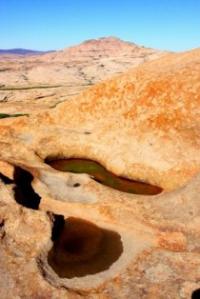You are here
Sights granite massif Bektau ata.


The nature of Central Kazakhstan.
“Why do you go away? So that you can come back. So that you can see the place you came from with new eyes and extra colors. And the people there see you differently, too. Coming back to where you started is not the same as never leaving”
Terry Pratchett. “A Hat Full of Sky”.
Karaganda of province of nature.
Some 70 km north of the town of Balkhash one of the most noteworthy places of Northern Pribalkhashye is located, the mountain oasis Bektau-Ata. Its highest peak is a peculiar landmark in this diversity-lacking expanse.
The highest point of the mountains, the Bektau-Ata Peak, reaches 1214 meters above sea level (its height from the foot to the peak is about 600 meters). In the western part of the massif are located three other peaks: Sarykulzha (1082 meters), Konyrkulzha (976 meters) and Karashoky (893 meters).
The Bektau-Ata Mountains are rich in whimsically-shaped rocks. Over thousands of years the processes of weathering have eroded away the granites and created real pieces of art that are nowadays give descriptive names such as Grib (Mushroom), Sunduk (Trunk), Cherepakha (Tortoise), Trekhzubka (Trident), amongst many others.
There are several rivers in the mountains, which are watered only in April and May. Lack of water in a drought season can be compensated by several tens of springs (we should mention, though, that many springs can also dry up in the very hot weather) and even hot-wells.
The most famous spring is situated in the legendary Atabek’s cave. The cave is located at a height of 80 meters from the foot of the mountain and stretches 50 meters northeastwards. The cave is connected with a legend about the saint Atabek, in honor of whom the whole mountain massif had been called.
Atabek lived in the period of Kazakh-Jungar wars. When escaping from his enemies, the elder took shelter in a cave, located in a sheer cliff, which had not been found by the pursuers. Allah created a fresh spring in the cave, so that Atabek did not die of thirst. The spring still exists to the present.
It should be mentioned that this cave was considered sacred long before the events described happened. It is believed to have been in use by the Stone Age people. Later Turkic women would come here to ask the heavens for a child and make a sacrifice to the goddess of fertility and domestic hearth, Umai.
The cave is still considered to be life-giving and to render help to barren women. Besides Atabek’s cave, there are many other caves in the Bektau-Ata Mountains. Their depths are rich in various minerals, particularly in rock crystal, morion and piezoquartz.
There grow several endemic plants, for example the Bektau-Ata sweetvetch, and a rare plant Kessler’s astragalus. The archa juniper (Juniperus semiglobosa) that can find moisture in the cracks of rocks is the most widespread inhabitant of the massif.
The forest is represented by small but numerous aspen and willow woods. Among the animals there are the argali (Ovis ammon), the roe deer (Capreolus capreolus), the mountain hare (Lepus timidus), the Mongolian pika (Ochotona pricei), the steppe pika(Ochotona pusilla), the rare five-toed dwarf jerboa (Cardiocranius paradoxus), the golden eagle (Aquila chrysaetos), the saker falcon (Falco cherrug), the black grouse (Tetrao) and many others.
Reptiles include the dione ratsnake (Elaphe dione) (innocuous to man) and the halys pit viper (Ancistrodon halys) (a dangerous poisonous snake). In the secluded nooks of the Bektau-Ata mountains one can find mumiyo – a remedy that had been known in the East for millenniums.
This substance (mountain wax of organic origin) is formed there due to vital functions of the Mongolian pika. The greater the age of mumiyo, the more valuable it is.
Authorship:
Vitaliy Shuptar. http://www.discovery-central-asia.com
Photos
Alexander Petrov.







